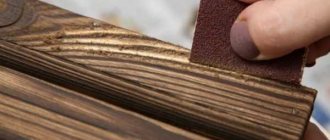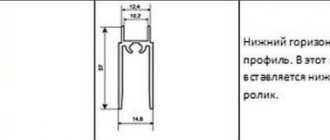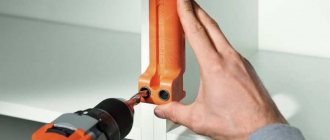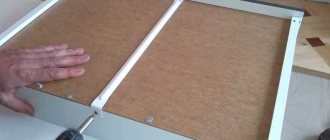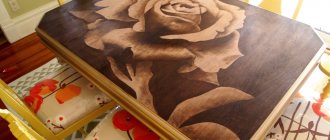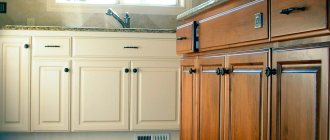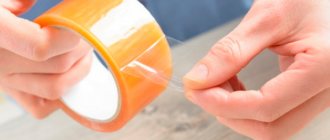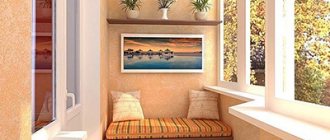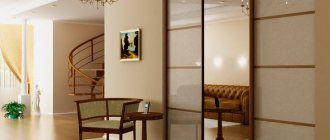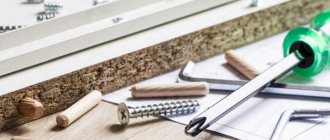Furniture made from laminated chipboard has been and remains the priority purchase option for the vast majority of our population. Perhaps its main advantage is its affordable price, which can be obtained by using chipboard that is inexpensive relative to other materials (for example, wood). Thanks to the lamination of the surface of the board, the furniture acquires a quite decent appearance and fits well into almost any interior design of the room.
However, like any other product, such furniture is prone to damage during use or transportation. Now we will look at what damage is typical for this type of furniture, how restoration and repair can be carried out.
Door repair
The most common breakdown of cabinet furniture is the failure of doors. This could be a simple misalignment due to unaligned hinges, wear, tearing out of the fasteners from the base, or spontaneous opening.
Often, door misalignment occurs due to improper adjustment of the fittings. Its design provides for the presence of 2 auxiliary bolts. One is responsible for the fit, the other regulates the position of the doors relative to the front plane. By experimenting with them a little, you can return the doors to the correct position.
If this step does not bring a positive result, the loop will need to be replaced. There is nothing complicated about this. You just need to buy another loop and put it in a given place, screw it in with self-tapping screws and adjust it.
To keep the doors closed, magnetic strips and response blocks are used. The first thing to do if spontaneous opening occurs is to clean both halves or correct their position relative to each other. It didn’t help, which means they need to be replaced.
And the most difficult thing is that the integrity of the slab has been compromised, and the screws that held the hinges in place have been torn out. You can try filling the holes with PVA glue or silicone, which does not lose elasticity after drying. After drying, secure the curtain again. But in most cases, you will have to move the fittings to another place, slightly higher or lower than the previous one.
Repair of cabinet furniture
Cabinet furniture can be made of solid wood, MDF or chipboard (chipboard) panels, coated with paints or plastic laminate, and decorative inserts made of glass, metal, and plastic.
Over time, the appearance of even the highest quality interior items wears out, scratches and chips appear on the surface, the color fades, laminate and veneer peel off. In any of these cases, a complete, partial repair of cabinet furniture or its renewal is carried out.
Similar articles:
| How to cover a kitchen with self-adhesive film with your own hands |
| Furniture stickers |
| DIY kitchen decoupage |
| Installing an apron in the kitchen with your own hands |
Cosmetic repair of cabinet furniture
Minor damage can be repaired without resorting to radical action. These include scratches on the varnish coating, small chips in places of constant mechanical impact, the presence of small areas where the varnish has lost color or transparency under the influence of high temperatures and moisture.
Scratches just need to be waxed and thoroughly polished with felt. With chips the situation is a little more complicated. First, the edges are sanded with fine sandpaper to create an even transition from the old layer to the base material. Then this place is varnished several times with intermediate sanding. The entire surface is leveled to smooth lines of the original state.
Removing chips is similar to the process of partially restoring the original appearance of the paint surface. First you need to identify the area that will be restored and completely get rid of the coating on it. Then the same painting and varnishing takes place using carefully selected color products. Don’t forget to smooth out the transition after each layer using a grinding machine or the finest sandpaper.
Cosmetic repairs also require peeling off the laminated film or veneer on the surface of MDF and chipboard in some places. This occurs as a result of constant exposure to elevated temperatures and the loss of the adhesive layer of its bonding properties. The problem is resolved by gluing the coating using construction adhesive or PVA.
How to quickly get rid of the borer beetle
The sharpening beetle is the enemy of furniture. It poses a threat not only to the furniture in which it has settled, but also to any other furniture in the room, or even to the house if it is made of wood.
It's easy to spot. Small holes on the furniture indicate that a woodworm lives in it. As woodworms reproduce, they penetrate everywhere. If they are not destroyed promptly and promptly, the furniture will perish. Read on to learn how to get rid of the borer beetle.
To combat the borer, special chemicals are sold - insecticides. The method of their use is recommended by the manufacturer. First, vacuum the entire surface of the damaged furniture to remove dust from the holes, then inject the product into the holes using a syringe or pipette. Treat the entire surface of the furniture by applying the composition with a brush.
There is also an old, time-tested option - treatment with dichlorvos.
Another simple way is to paint the product with topcoat paint on any base. Grinder larvae will not be able to penetrate layers of paint.
Methods of heating and freezing are safe for health. Warm up the furniture thoroughly with a stream of sighted air (60 °C), using a construction or regular hairdryer. If possible, freeze the item by leaving it outside at a temperature of -5°C or lower.
How to glue veneer using an iron
Veneer most often suffers on the edges of countertops, doors, and drawers. If it is impossible to repair the damage or a fragment of veneer is lost, then the old veneer in the damaged area must be replaced with new one.
Replacing the entire surface with damage, that is, veneering large areas, at home, without experience, will not ensure uniform sticking of the veneer, its pressing and drying.
To repair the surface of furniture, choose veneer of a suitable tone; if this is not possible, use the lightest version of veneer, which you can then tint yourself, but when choosing, pay attention to the texture of the wood.
Remove the damaged piece of veneer with a sharp knife. First, mark the cut line, and then quickly cut a piece of veneer. If the wood or chipboard underneath the veneer is damaged, putty it and level the surface.
If chips or losses of veneer are insignificant (1-2 cm) and it is not possible to buy veneer, fill these areas with wood putty, after drying, sand and paint with acrylic paint to match the surface.
Before gluing the veneer, prepare the following tools and materials:
- suitable veneer;
- PVA glue (or “Moment” glue, “Liquid nails”);
- sharp knife;
- iron;
- syringe;
- sandpaper, block;
- cotton fabric or cloth;
- paper;
- flute brush.
When repairing furniture at home, follow these instructions to repair damaged veneer:
Apply a small amount of PVA glue to the prepared underlying surface using a flute brush.
When cutting, try to keep the cut line slightly wavy and the piece cut with a slight allowance. Coat the cut piece of veneer with PVA glue.
Place the veneer in place so that the direction of the grain matches. After this, it is advisable to firmly press the veneer with a wooden block.
To speed up the gluing process, use an iron. To do this, place a cloth or sheet of paper between the veneer and the iron and press the iron against the surface for a couple of minutes.
If the original veneer is not damaged, but swelling has occurred, it can be returned to its place by ironing it with a hot iron through a damp cloth.
- If the previous method did not help, it means that the adhesive properties of the glue have been lost. Cut the swollen coating and use a regular syringe to inject PVA glue under it. Press down on top with a weight and leave for a day.
Why is chipboard puttied?
The building material is perfect for rough work. With its help, you can form a prefabricated screed, level ceilings and walls, make partitions, etc. You need to putty the slabs when laying soft or rolled materials, wallpapering the ceiling and walls or painting, since in these cases joints are formed that need to be closed. Putty mixtures are best suited for this purpose.
The second reason why it is important to putty chipboard is because of the sheets themselves, which have an uneven, rough surface. Before painting, wallpapering or embossed thin-layer plaster, the base must be perfectly flat. Once again, putty will help eliminate all defects and bring the surface to the desired state.
If we talk about whether it is possible to putty chipboard, experts confidently answer - it is possible! But you only need to use thin-layer compounds intended for work on wood and chipboard.
The treatment will help make the coating smooth, durable and vapor-permeable. This provides reliable protection against rotting, destruction, mold and mildew.
Benefits of DIY restoration
Restoration done independently allows you to save the amount that would be spent on the services of a professional, and use it to purchase higher quality materials and furniture fittings.
What is important is the fact that all work will be performed to a high standard. At each stage there will be control of the cleanliness and usefulness of finishing materials.
Another big plus is the opportunity to experiment at any stage of restoration, which is completely excluded if the wardrobe or chest of drawers is given into the wrong hands.
The restoration process itself is simple. You need materials and tools that can be found in any home or freely purchased at construction or crafts outlets. The main thing is to know the sequence of stages and possible methods and options on how to update furniture with your own hands, what to use in this or that case, what actions are acceptable with different materials.
How and how to repair scratches on furniture
Almost always there are various scratches on the surface of old furniture. This is due to the fact that the old generation of varnishes, and these were mainly alcohol varnishes, did not have either chemical or mechanical strength and did not form a strong protective film. Read more about what and how to repair scratches on furniture further in the material.
Of course, you want to remove such damage without much effort, without resorting to complete cleaning of the surface. But no recipe can give a 100% guarantee, since the result is determined by a number of factors, and one of them is the type of varnish coating.
Deep scratches can be filled with a mixture of PVA glue and wood flour resulting from sanding and sanding wood. Remove excess immediately with a spatula. After drying (after 3-4 hours), if necessary, paint the putty with acrylic paint in the same color as the surface.
How to remove a scratch on furniture if it is so deep that the wood is exposed? Damage can be corrected with acrylic paint, stain, or impregnation of the appropriate color. Using the tip of a thin brush, paint only the scratches, applying the composition in several layers.
How to remove cracks and other damage to furniture
Small cracks (up to 2 mm) can be filled with epoxy resin and heated with a hair dryer, both the surface and the glue. The resin hardening time is 4-6 hours.
Since it is not at all difficult to remove cracks on small furniture, we will focus on deep damage. If there are very deep cracks in the furniture frame, they require filling with epoxy glue in two or three steps and sanding after two to three weeks.
Filling large depressions and cracks requires puttying. Finding the right color putty is not easy. Using water-based wood putty, you can tint it with acrylic paints to achieve the desired color.
Features of working with glass surfaces
In order not to damage the fragile glass surface, you need to take into account a number of nuances during processing. The main rule is to be careful. It is also important to select suitable products that do not harm glass products to complete the work.
Paste GOI
Deep scratches on glass can be removed using GOI paste. If possible, glass should be removed from furniture for ease of processing. A small amount of paste is applied to the fabric and spread over the surface. Then rub the product in a circular motion into the damaged areas. Remains of GOI paste after treatment are removed with a damp cloth.
Nail polish
Minor scratches on the glass coating can be easily masked with nail polish. A prerequisite is the transparency of the varnish. The substance must be applied with a brush to the scratched areas and wait until the varnish fills the crack and dries. The remaining varnish is carefully wiped off the surface with a soft cloth.
